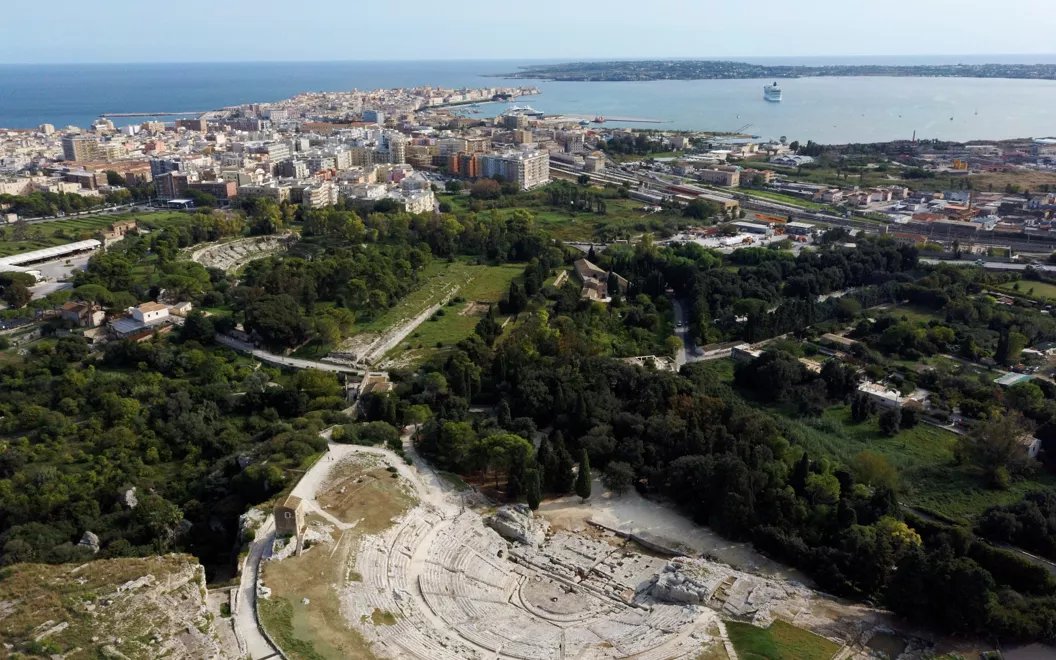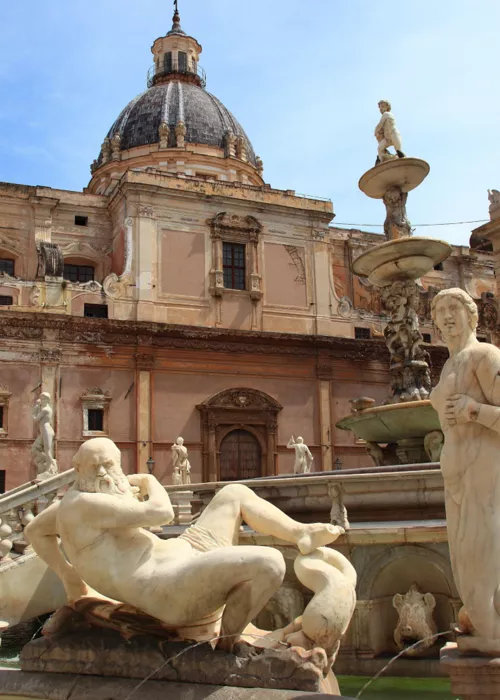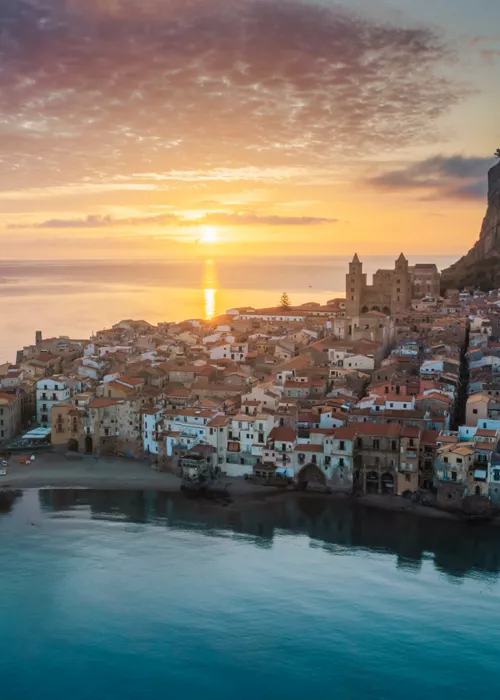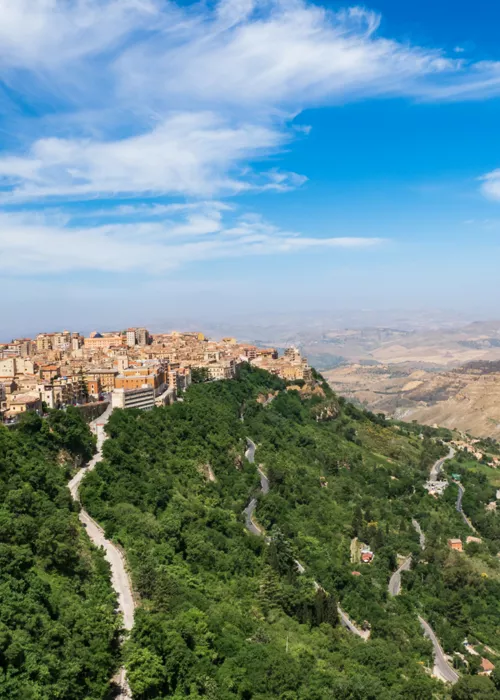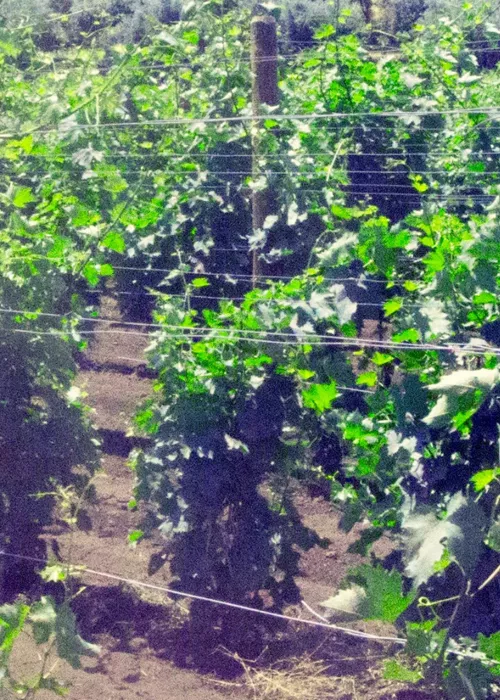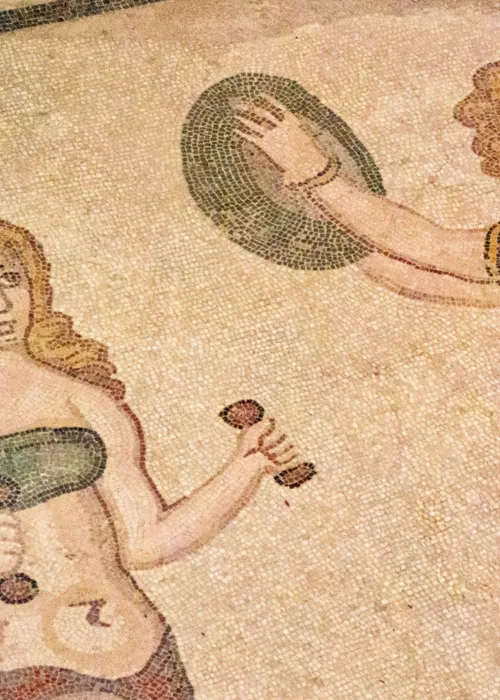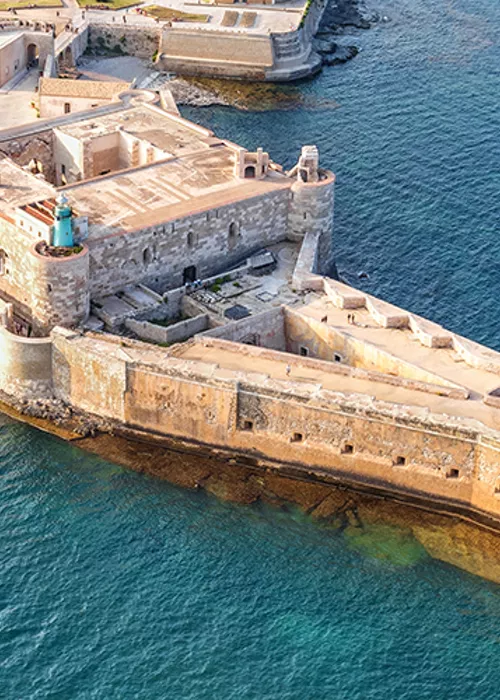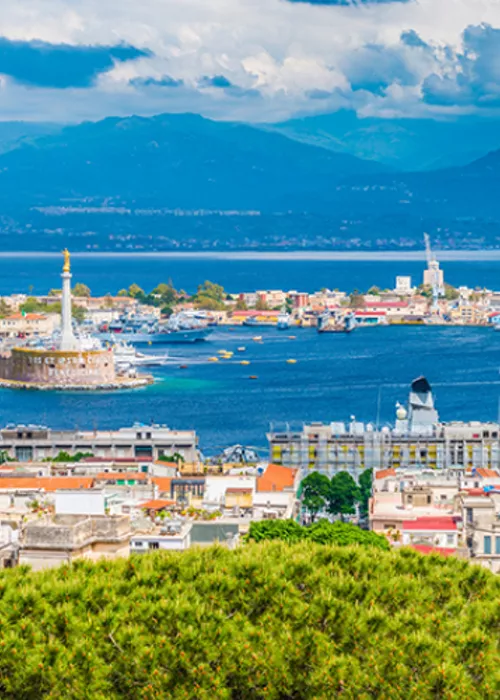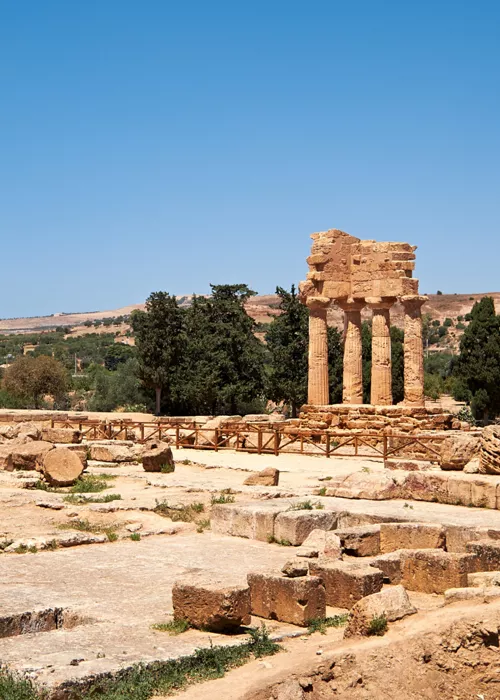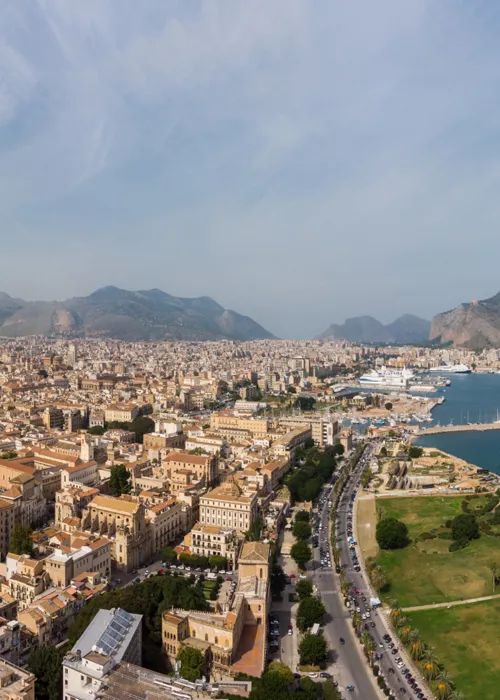Euryalus Castle

Approximately 8 kilometres from the centre of Syracuse, on thehighest point of the Epipoli plateau, in the hamlet of Belvedere, is the Euryalus Fortress, in one of the most spectacular scenic spots, from where you can gain an overall view to see the city's history in context. From here you can appreciate the extent of Greek Syracuse while enjoying one of the most beautiful views in Sicily. The fortress was built at the beginning of the 4th century BC by Dionysius I, the Elder, and effectively performed its defensive task until the fall of Syracuse under Roman rule. Worthy of note is the defence system of ditches, which had the task of slowing down enemy assaults and providing several escape routes for the soldiers.
Its strategic location and architectural structure, according to innovative canons for the time of its construction, make it a jewel of military engineering. You will neeed a map to find your way around the vast complexity of the ruins, which extend over an area of one and a half hectares. Exploring the the history of Euryalus Fortress is certainly worthwhile. Originally consisting of a single block in the shape of a ship's prow, it now appears divided into two sections: a rectangular one, to the west, and a trapezoidal one, to the east. The two parts are separated by a wall built by the Byzantines to use only the square half of the fortress.
The west façade has various defensive elements: an advanced outpost, once connected to the castle by a mighty 15-metre drawbridge, the pylons of which are barely visible; five towers, which had platforms for catapults. The eastern half of the castle, trapezoidal in shape, where the three cisterns that served to supply the city with water once stood, is connected to the Dionysius Wall; here the fortress opens up to the city.
The Greek Theatre

The greatest expression of theatrical architecture and stage technique of the Greek period that has come down to us, it derives from an extension that Hieron II commissioned in the 3rd century B.C. of an earlier theatre dating back to the 5th century. In addition to performances, it was used for assemblies of the people. Carved out of the rock of the Temenite hill, the theatre is oriented towards the sea and offered a marvellous view to spectators seated in the elevated part of the tiers (of which no trace remains as they were not carved but built from blocks). The cave, originally consisting of 67 tiers of steps divided by service stairs into eight 'segments' (46 remain), is cut horizontally at mid-height by a wide open passageway, which has the names of certain deities and high personalities, after whom the various sectors were named, engraved on its northern wall.
The orchestra and stage areas, as they appear today, are the result of modifications made in Roman times to adapt the theatre for other kinds of performances. The abandonment of the structure began with the invasions of the Vandals and the Goths, in 440, and culminated with its partial destruction in 1526, when Charles V ordered that the marble roofing be removed and used for the construction of the fortifications of Ortigia. The cavea of the theatre is dominated by a rectangular terrace carved into the rock, from which two long porticoes protruded, offering shelter in case of rain.
In the centre of the wall is a large artificial cave with an architectural prospectus, from the centre of which an aqueduct fed a fountain. It is thought that the cave, in which some statues depicting the Muses, now on display in the 'Paolo Orsi' Regional Archaeological Museum, were found, was a Mouseion, or seat of the Actors' Guild. The rock face of the terrace is covered with small rectangular niches used for the cult of heroes, with votive tablets (pinakes), and small caves in the rock preserve tombs from the Byzantine period.
Every year, between May and June, the Greek theatre in Syracuse returns to its original function, hosting a prestigious theatrical review, curated and organised, since 1914, by the National Institute of Ancient Drama. Seated on the ancient stone steps, spectators are enchanted by the timeless charm and beauty of the place and experience the thrill of being transported back through the centuries, guided by the words that resonate among the ancient stones and caught up in the period settings of the tragedies and comedies of Aeschylus, Sophocles, Euripides, Seneca and Aristotle, revisited by renowned and outstanding directors and actors.
Latomies and ear of Dionysus

These are the ancient stone quarries from which, since Greek times, blocks of white-grey limestone were extracted and used to construct the buildings and walls that have given the city its unmistakable bright colour. The quarries, which were once dark caves, were opened as a result of the various collapses caused by earthquakes; the sun and moisture has covered them with lush vegetation. The white limestone walls, corroded into bizarre shapes, are thus animated by citrus gardens, immense ficus trees, magnolias and delicate hornbeams.
Within the archaeological area, visit the suggestive latomia del Paradiso, a group of quarries known above all for the presence of the so-called Ear of Dionysus, due to its characteristic shape similar to the interior of a human ear. The nearby cave of the Cordari is a vast artificial cavity supported by pillars carved into the rock.
The cave of Salnitro, the mouth of which is covered by a gigantic boulder, and the latomia dell'Intagliatella, with high rock walls, is followed by the smaller latomia di Santa Venera, transformed into a lush garden, which extends around a majestic sacred fig tree. The walls are carved into niches connected with the cult of heroes.
Paolo Orsi Regional Archaeological Museum

Inside Villa Landolina, a large green space with a wealth of historical remains (a small latomia houses three pagan hypogeums and the Protestant Cemetery), a structure built in 1967-86 to a design by Franco Minissi houses the Museum, which covers 9000 square metres and contains more than 18,000 exhibited items. The history of the collections and their location is presented in a large circular space in the centre of the centre of the building. This is where the journey begins to discover the succession of civilisations in the Syracuse area, from prehistory to the early Christian era. You can visit all of the many sectors, or simply choose the ones that interest you most.
Sector A is dedicated to prehistory and protohistory, from the Paleolithic period to the time of Greek colonisation. Of particular interest are the finds of the so-called Castelluccio culture, from a site near Noto, with carved doors, painted ceramics and bone objects of fine workmanship, as well as the funerary artifacts of the Thapsos necropolis explored by the archaeologist Paolo Orsi, after whom the museum is named. Sector B is focussed mainly on the topic of Greek colonisation, with particular reference to Megara Hyblaea and Syracuse.
With regard to Megara Hyblaea, have a look at the oldest ceramics and the splendid sculptures from the Archaic period, including the funerary statue of the doctor Sambrotidas, from the 6th century BC and, from the same era, the painted limestone statue of a mother goddess nursing twins. There is no shortage of finds from the funerary artifacts found in the city's necropolis. The focus on Syracuse is centred on statuary collections and the mainly ceramic material recovered from the excavations in the Acradina district (Piazza Vittoria) at the shrine of Demeter and Kore, as wall as on the funerary artifacts and terracotta collected from the temple of Apollo.
From the temple of Athena, a fragment of a marble cornice with lion-head spouts (480 BC) and a finely crafted statue of a winged Victory according to the archaic scheme of flight. The coastal area south of Syracuse is represented in sector C, where the finds recovered in Eloro, a coastal outpost of the city, and from the colonies of Akrai, Kasmenai and Camarina, including a terracotta group depicting a knight, are on display.
Other finds come from inland Sicily and from the important Doric colonies of Gela and Agrigento. From Francavilla di Sicilia, in particular, comes a vast deposit of pinakes, terracotta votive paintings from a shrine of Demeter and Kore. On the first floor, sector D, dedicated to the Hellenistic and Roman eras, houses the splendid Venus Anadiomene ("emerging from the sea"), a Roman era copy of a Greek original, also known as Venus Landolina, after the archaeologist who found it in 1804, and a beautiful series of portraits from the Roman era.
Sector F, dedicated to the Christian and Byzantineera, exhibits finds from the catacombs of St John, including the sarcophagus of Adelfia (4th century AD), found in 1872, with friezes of Christian tradition. In front of the sarcophagus is the epigraph of Euskia: dating back to the 5th century AD, the earliest record of the cult of Lucia, patron saint of Syracuse. The Medallion collection is set upin the basement of the museum, exhibiting a heritage of extraordinary testimonial value for the coinage of Greek Sicily, from the archaic to the medieval period. Part of this new sector is dedicated to jewellery, dating from prehistory to the modern era.
Latomia dei Cappuccini

At the foot of the seventeenth-century Capuchin Convent, the Latomia dei Cappuccini, dating back to the fourth century BC, is the largest, deepest and oldest of the Syracuse latomias, and can even be seen from the top of via Acradina.
The particular climate, warm but humid and shady, has transformed the vast quarry into a lush garden where strange white rock shapes stand out, with caves, vaulted bridges, vertical walls and high pylons. Ramps of stairs and twisting walkways link the different levels produced by the long excavation work, landslides that have occurred over the centuries and the erosion caused by the weather.


